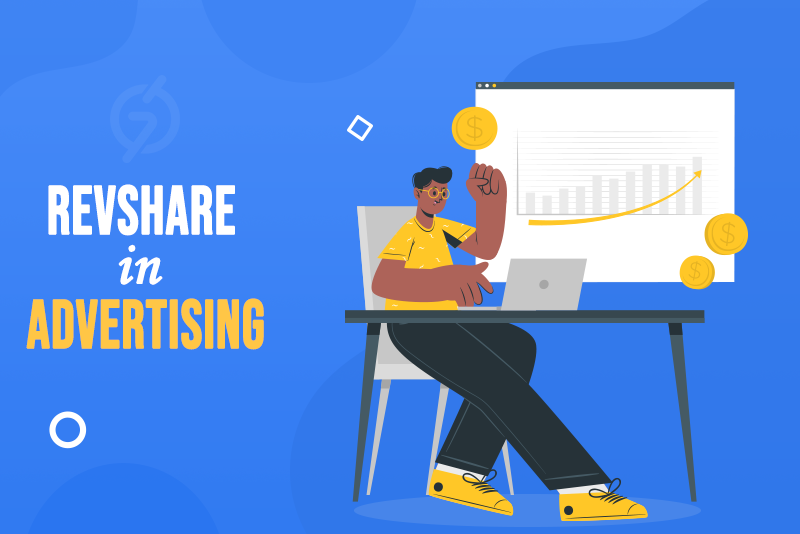Imagine a world where publishers and advertisers work together to succeed. This idea is at the heart of RevShare, a performance-based revenue model that is becoming more popular in the digital era. But what is it, and how does it operate?
The revenue-sharing model is a financial model where publishers and advertisers share the revenue from ads placed on a publisher’s platform.
This model ensures that both parties benefit proportionally to the success of the ad campaign. It’s a win-win approach: advertisers only pay for results, while publishers are incentivized to host effective ads. In the world of booming digital advertising, understanding RevShare can unlock new revenue streams and fuel collaborative growth.
Are you a digital publisher or content creator looking to monetize your platform? Revenue sharing could be a great option for you. Let’s explore how this model works and why it’s becoming more popular in the advertising world.
What is RevShare?
Affiliate marketing, which involves bringing genuine customers to businesses in exchange for a share of profit or commission, is now one of the trending ways to generate a side income. Some affiliates use it as their permanent source of income, and some use it as a flexible way to supplement their main income streams.
RevShare, short for revenue sharing, is when advertisers or product providers give affiliates a share of the profit they make from customers the affiliates bring in.
This can include all future purchases made by those customers for a period of time or even for as long as they remain customers. The revenue-sharing model encourages affiliates not only to attract customers but also to keep them engaged for the long term. It’s a common practice in online businesses where partnerships help both sides earn more money together.
Revenue Share Offer Examples: Platform, Country, Rates & Details
We have researched some revenue-sharing models of specific platforms. This can help you understand how RevShare in advertising works:
1) Platform/Network- WebPartners
- Country- US/UK/Germany
- Revenue Sharing Offer- 125 dollars for each sale ( This is also applicable for iGaming)
2) Platform/Network- Dixie Botanicals
- Country- US
- Revenue Sharing Offer- Qualified Purchases Only- $50 per sale.
3) Platform/Network- Advendor
- Country- US
- Revenue Sharing Model- 15% of sale (Payment will be processed in dollars)
4) Platform/Network- Booking.com
- Country- US
- Revenue Sharing Model- 4% commission on any completed hotel stay.
An Analysis of the Benefits of RevShare
The revenue-sharing model not only benefits publishers but also gives various advantages to advertisers. Here, we have outlined the specific benefits for both sides.
Benefits for Advertisers
- Cost Efficiency- RevShare minimizes upfront costs as advertisers pay based on actual sales or conversions generated. This model ensures a direct correlation between ad spend and performance, which saves the advertiser money by tying expenses directly to results achieved.
- Risk Mitigation- Affiliates are like sales assistants for the businesses who work for them actively. Here, businesses do not have to worry about giving them a salary. They just have to give a small share of their profit, which is generated through the affiliate’s promotional efforts and successful sales referrals. Advertisers lower their risks by paying only when they get sales, motivating publishers to focus on bringing in valuable traffic and engaging audiences, which makes campaigns more effective.
- Scalability- RevShare models are flexible and can adapt to growth. Advertisers have the freedom to adjust their campaigns based on performance. They can collaborate with multiple publishers without a large initial investment, allowing them to experiment easily with new audiences and tactics to improve their campaigns.
- Targeted Audience Reach- Advertisers benefit from RevShare through specialized communities. Publishers often have a well-defined audience. By partnering with publishers who reach their target market, advertisers can access a qualified pool of potential customers. This targeted approach filters the irrelevant audience for their business. Let’s take an example that can help you understand this benefit better.
Example
A sports apparel partner with a fitness blog. The blog audience who is already interested in athletic wear will be more likely to respond to the advertiser’s message. This targeted strategy results in higher CTRs, Conversions, and ultimately, a better ROI for advertisers.
Benefits for Publishers:
- High Earning Potential- RevShare surpasses the limitations of fixed-rate models and allows publishers to increase their income. For example, a publisher with a dedicated audience that doesn’t often click on standard banner ads would see their earnings remain flat in a fixed-rate model. With the revenue-sharing model, they have the opportunity to earn a commission for each sale or subscription they generate. This means that the more effectively they promote the advertiser’s offerings, the more they can earn. This model encourages high-quality content creation and audience engagement strategies.
- Diversified Revenue Streams- In today’s time, having various income sources is beneficial for publishers because it provides financial stability and reduces dependency on single revenue streams. The RevShare model opens the door for publishers so they can make a contract with various advertisers who offer them a significant share for their promotion efforts. By entering into revenue share agreements with different advertisers, publishers can create a reliable income.
This financial stability helps them grow their platforms, improve content, reach more people, and increase revenue from different sources. - Stronger Partnerships- RevShare creates a teamwork atmosphere where advertisers and publishers work together towards the same goal of boosting sales and conversions. This cooperative approach promotes open communication and careful planning. Publishers can learn what advertisers need so they can adjust content and targeting strategies to get the best results.
- Performance-Based Recognition- RevShare rewards publishers for creating engaging content and effectively connecting with their audience. Publishers earn based on their ability to attract and convert the ideal audience for the brands with which they partner in revenue-sharing agreements. This model gives publishers more control over their earnings and acknowledges their efforts. Publishers who excel at building active communities are rewarded directly by the advertisers for their ability to generate sales and conversions.
Comparing Revenue Share and CPA Payment Models
RevShare vs CPA: Which commission model is right for you? Let’s find out together.
Revenue Share

How it Works
Suppose you partnered with an online clothing store. When you refer someone to a clothing store, you can earn a percentage (e.g.,15%) of the share that person spends, not just on their initial purchase. This system rewards you for building a loyal customer base that makes repeat purchases
Advantages
You have a great opportunity to earn more, especially if the people you refer become loyal customers who spend a lot. Your success ties directly to the company’s goals of keeping customers happy.
Suitability
It is ideal for those with a strong, engaged audience that converts well into paying customers. It works best when you focus on building long-term relationships with your audience.
Consideration
The RevShare model relies on customer behavior, which means that your income can vary. While a single high-spending customer can result in a large payout, others may not convert or spend much, leading to lower earnings. To build a consistent income stream, you need a stronger customer base that not only converts well but also continues to engage with the company. This requires time and effort to develop.
Additionally, unlike in CPA, where you get paid for a specific action, it takes longer to see results with the revenue-sharing model. You might not earn a significant amount until your referred customers make repeat purchases or spend a certain amount. This can be discouraging if you are looking for a quicker return on your marketing efforts.
CPA (Cost Per Action)

How it Works
It is like receiving a commission for each action taken through your marketing effort. With CPA (Cost Per Action), you receive a fixed amount, for example, $10, for a specific action, such as signing up for a free trial or making a first purchase. This approach focuses on driving immediate results rather than long-term engagement.
Advantages
It is easier to predict earnings compared to RevShare and less reliant on long-term customer behavior. It is a good option for short-term promotions or campaigns that aim for quick sign-ups or downloads.
Suitability
CPA is a suitable option if you are new to affiliate marketing or have an audience that has yet to become paying customers. As we already discussed, it is effective for short-term objectives or driving initial actions.
Consideration
When using a CPA, the income can be predictable, but there is a limit to how much you can earn. Suppose the customers you refer spend a small amount after their initial qualifying action (like signing up or downloading). In that case, your overall earnings might be lower compared to RevShare, where you earn from their total spending. Moreover, focusing on immediate conversions with CPA might encourage promotion to anyone who clicks, regardless of their long-term value as a customer.
This could result in lower-quality leads for the company as customers might not be genuinely interested in the product or service. This short-term focus might not be ideal for companies looking to build a good customer base.
A Look at the Potential Hurdles of RevShare
Revenue sharing is a common revenue model where advertisers share the profit percentage with publishers for their sales efforts. While this model has several advantages, it also comes with a number of challenges. Here are some of the key difficulties linked to the revenue-sharing model:
- Unpredictable Income- Revenue sharing can lead to inconsistent income for affiliate publishers. Because revenue is based on sales, it can vary a lot. This can make it hard to plan and budget, especially for smaller affiliates who depend on a steady income. Partners should be prepared for these fluctuations and have contingency plans in place for periods of lower revenue.
- Reliance on Brand Performance- Your earnings are closely linked to the partner company’s success in converting leads and keeping customers. If the company provides poor products, has a negative reputation, or lacks effective marketing strategies, it can affect your capacity to earn money through referrals.
- Tracking and Attribution Challenges- Accurately tracking referred customers and their spending to ensure you receive proper commission can be complex. Technical issues and a lack of clear attribution models from the partner company can lead to disputes or missed payouts.
How Revenue Sharing Model Works
Here are five steps to help you understand how RevShare works:
- Partnership & Agreement- The first step is to partner with a company that offers a revenue-sharing program. This usually involves signing an agreement that outlines the commission rate ( a percentage of the sale) you will earn and any specific terms, such as qualifying actions or tracking methods.
- Promotion & Referral- You promote the company’s products or services to your audience through methods such as blog posts, social media recommendations, or affiliate links. The objective is to pique interest and drive clicks to the partner’s website.
- Customer Journey and Tacking- When someone clicks your affiliate link or uses your referral code, the partner company tracks their activity (through cookies or other methods). This ensures you get credited for any sales generated from your efforts.
- Purchase & Commission- If the referred customer makes a qualifying purchase (e.g., buys a product or subscription), the sale is recorded. You then earn a percentage of the total sale value based on the agreed-upon commission rate.
- Payment & Reconciliation- It is the last step of RevShare. In this step, the partner company accumulates your earned commissions over a specific period (e.g., monthly) and sends you a payout according to their payment schedule. You may need to compare your records with theirs to ensure accuracy.
Conclusion
The RevShare model provides a good alternative for both publishers and advertisers. Publishers can potentially earn more and have diverse income sources, while advertisers can reach specific audiences and only pay for actual results. However, inconsistent income and dependence on partner performance can be challenging. Understanding these factors and the five-step process of RevShare can help you determine if this model suits your objectives.
Frequently Asked Questions (FAQs)
What is RevShare?
Ans. Revenue share is a model where advertisers pay publishers a commission from the profit that is generated by affiliates’ links on the publisher’s platform. Advertisers only pay when someone clicks on that link and buys something, and publishers earn a commission on those sales.
What is the difference between RevShare and CPA?
Ans. With revenue share, publishers earn a percentage of the total sales they generate, while with CPA (Cost Per Action), they get a fixed amount for a specific action, like a signup or download.
Which revenue-sharing model is right for me as a publisher?
Ans. If you have a strong, engaged audience that converts well, RevShare can be a great option. CPA might be a better choice if you are new to affiliate marketing or your focus is on short-term campaigns with quick actions.
Can I negotiate the commission rate in RevShare?
Ans. Negotiation is sometimes possible, particularly for publishers with a sizable and engaged audience.
How long does it take to see results with RevShare?
Ans. It can take longer to see results with revenue share compared to CPA because it relies on customer purchases, which can take time.


















